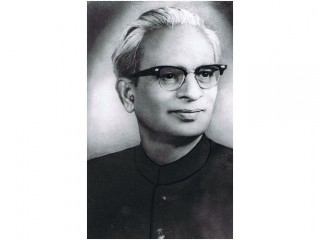
Khaliq Ahmad Nizami biography
Date of birth : 1925-12-05
Date of death : -
Birthplace : Amroha,India
Nationality : Indian
Category : Historian personalities
Last modified : 2011-10-11
Credited as : Head of the Department of History at Aligarh, dean of the social sciences, Indian ambassador to Syria
Khaliq Ahmad Nizami (born 1925), an Indian historian, religious scholar, and diplomat, was best known for his work on the history of medieval India and in particular for his studies of the Muslim community of that time.
Khaliq Ahmad Nizami was born in the town of Amroha in the United Provinces of British India on December 5, 1925. He was the son of Aziz Ahmad and Sayyidah Nizami. Khaliq Ahmad received his education in India, and though he travelled extensively and gained much recognition abroad, he also largely pursued his academic career in his native country. He attended the University of Agra, where he completed the M.A. in history in 1945. In the following year he was awarded the LL.B. degree by the same institution. Married to Raziyah Nizami, the couple had five children.
In 1947 Nizami joined the staff of the Aligarh Muslim University in Aligarh, India, in the Department of History. The Aligarh Muslim University was the premier institution of higher education for Muslims in India in both pre-partition and post-partition days. In the period between 1937 and 1947 it was the foremost center of the Muslim political agitation that eventually led to the partition of India and the creation of Pakistan. Nizami was among those Muslim intellectuals who opted for Indian nationalism and the cause of the Indian National Congress. In consequence, he remained in India with his family when the country was divided in 1947.
Nizami's rise in position at Aligarh was both steady and swift. In 1953 he became reader in history, and in 1963 he was promoted to the rank of professor. The latter appointment was accompanied by his being made head of the university's Centre of Advanced Study in History, which has numbered many of the best and most famous twentieth-century historians of India among its personnel. In 1968 he gained the respected title of senior professor of the university. He also played an important part in the administration of the Aligarh Muslim University. He acted as pro-vice-chancellor in 1972-1973 and in 1974 became vice-chancellor, the highest executive officer of the institution. In 1978 he was made the Indian ambassador to Syria, but at the same time between 1978 and 1980 he served as dean of the social sciences at the university. In 1980 he became head of the Department of History at Aligarh.
In addition to his formal duties in the university, Nizami was active in a number of extra-curricular and professional organizations, especially those designed to promote the study of Indian history. He served as secretary of the Islamic Studies Section of the International Congress of Orientalists held in New Delhi in 1963; he was president of the Medieval Indian History Section of the Indian History Congress convened at Allahabad in 1965; similarly, he served as president of the History Section of the Punjab History Congress in 1969. He was a member of the U.P. Regional Records Survey in Allahabad. He participated in many other congresses and conferences, both in India and elsewhere.
Nizami's principal scholarly concern was the history of medieval Muslim India, and the majority of his publications were in that field. For instance, he wrote extensively on the Sultanate of Delhi, giving particular attention to the religious dimensions of the history. In addition to a general book on the sultans of Delhi (originally in Urdu), he wrote studies on prominent sufis such as Shaykh Farid al-Din Ganj-i Shakir and on the saints of the Chishti order.
One of the more consequential of his efforts was the publication of the political correspondence of the 18th-century Muslim reformer and philosopher Shah Waliullah of Delhi; this correspondence provided the basis for an enlarged understanding of Waliullah's contribution to Indian Muslim history. There is also a group of works devoted to Sayyid Ahmad Khan, the founder of the Aligarh Muslim University and the most important intellectual and political leader of the Indian Muslims in the latter part of the 19th century. In addition to the studies of the life and times of Sayyid Ahmad and the history of the Aligarh movement, these studies include an illustrated album and a collection of poems about Sayyid Ahmad and some of his associates.
Perhaps the most enduringly important of his contributions is his work, together with Muhammad Habib, another Aligarh historian, on The Comprehensive History of India and his Supplement to Elliot and Dowson's History of India which has been a standard source (in translation) of original source materials for Indian history. In all, by 1984 Nizami had published 20 books dealing with various aspects of medieval Indian history and culture. His articles on these subjects, spread through a variety of publications, were even more numerous.
In addition to these publishing activities relating to works from his own pen, he was general editor of the Crescent-Lotus book series. He also served as director of the Sir Syed Academy, one of whose purposes is publication in the field of its interest.
In view of these activities Nizami must be counted among the select group of the most important contemporary historians of India. His position with respect to the study of Muslim India is one of even greater prominence.
The Indian reference work Who's Who; his writings should be available in any library that collects materials concerning India and its history. □
















